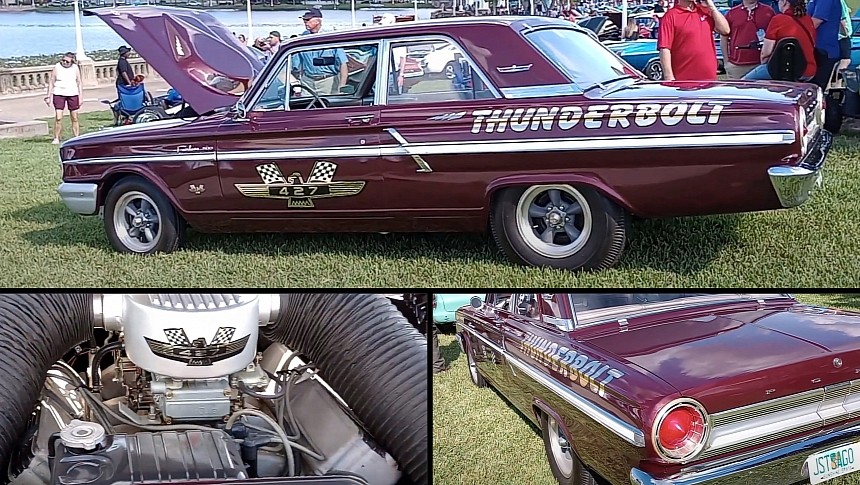The golden muscle car era officially began in the mid-1960s when the Big Three started dropping big-block engines in intermediate vehicles. However, Ford, GM, and Chrysler rolled out some fantastic rigs earlier in the decade due to their heavy involvement in drag racing and NASCAR.
I'm talking about lightweight full-size cars equipped with race-honed mills like the Impala Z11 and the Pontiac Catalina Super Duty. Chrysler had the Max Wedge engine before the mighty HEMI arrived in 1964, while Ford used a stripped-off version of the Galaxie.
The latter, however, wasn't fast enough for the Mopars and Chevys at the drag strip, so Ford decided to build a new Super Stock racer from scratch. Needing an even lighter vehicle, the company turned to the Fairlane, redesigned into a midsize for the 1962 model year.
The Fairlane was more than 600 pounds (272 kg) lighter than the Galaxie, but Ford took things up a notch and ditched all the unnecessary gear to make it even lighter. It removed all sound-deadening material, the heater, and the radio, while the factory glass was replaced with plexiglass panels.
The car also got fiberglass doors, hood, front fenders, and lightweight seats from the Econoline van. The early cars were also equipped with fiberglass bumpers. However, Ford switched to aluminum units due to racing regulations.
But the Fairlane also needed to be powerful and fast to tackle the Super Stock class, and the 289-cubic-inch (4.7-liter) V8 wasn't potent enough. To solve this issue, Ford shipped the cars to the Dearborn Steel Tubing company to have the engine bay reworked to fit the Galaxie's NASCAR-spec 427-cubic-inch (7.0-liter) unit.
Modifications included shaping the tubular headers around the front suspension, adding a tear-drop-shaped bulge in the hood for the high-rise intake, and replacing the high-beam headlamps with massive scoops.
Rated at 425 horsepower and motivating a car that tipped the scales at just over 3,200 pounds (1,451 kg), the NHRA minimum for the Super Stock class, the 427 V8 turned the Fairlane into a drag-winning monster.
Ford named it the Thunderbolt and homologated the setup just in time for the 1964 season. The car made its track debut with a win at the Winternationals and went on to take the NHRA Top Stock crown and the NHRA Manufacturers' Cup that year.
Ford built only 100 Thunderbolts in 1964, 49 fitted with four-speed manuals and 51 equipped with three-speed automatics. The burgundy example you see here is one of those cars. It's also one of only about 60 known to still exist and one of only 11 (some say 13) finished in the maroon hue Ford called burgundy at the time. All the other cars were painted Wimbledon White.
What's more, it's a finely restored example that's still highly original, which is something you don't see every day. It's one of those Thunderbolts that's probably worth well in excess of $200,000. Check it out in the video below.
The latter, however, wasn't fast enough for the Mopars and Chevys at the drag strip, so Ford decided to build a new Super Stock racer from scratch. Needing an even lighter vehicle, the company turned to the Fairlane, redesigned into a midsize for the 1962 model year.
The Fairlane was more than 600 pounds (272 kg) lighter than the Galaxie, but Ford took things up a notch and ditched all the unnecessary gear to make it even lighter. It removed all sound-deadening material, the heater, and the radio, while the factory glass was replaced with plexiglass panels.
The car also got fiberglass doors, hood, front fenders, and lightweight seats from the Econoline van. The early cars were also equipped with fiberglass bumpers. However, Ford switched to aluminum units due to racing regulations.
But the Fairlane also needed to be powerful and fast to tackle the Super Stock class, and the 289-cubic-inch (4.7-liter) V8 wasn't potent enough. To solve this issue, Ford shipped the cars to the Dearborn Steel Tubing company to have the engine bay reworked to fit the Galaxie's NASCAR-spec 427-cubic-inch (7.0-liter) unit.
Modifications included shaping the tubular headers around the front suspension, adding a tear-drop-shaped bulge in the hood for the high-rise intake, and replacing the high-beam headlamps with massive scoops.
Rated at 425 horsepower and motivating a car that tipped the scales at just over 3,200 pounds (1,451 kg), the NHRA minimum for the Super Stock class, the 427 V8 turned the Fairlane into a drag-winning monster.
Ford named it the Thunderbolt and homologated the setup just in time for the 1964 season. The car made its track debut with a win at the Winternationals and went on to take the NHRA Top Stock crown and the NHRA Manufacturers' Cup that year.
Ford built only 100 Thunderbolts in 1964, 49 fitted with four-speed manuals and 51 equipped with three-speed automatics. The burgundy example you see here is one of those cars. It's also one of only about 60 known to still exist and one of only 11 (some say 13) finished in the maroon hue Ford called burgundy at the time. All the other cars were painted Wimbledon White.
What's more, it's a finely restored example that's still highly original, which is something you don't see every day. It's one of those Thunderbolts that's probably worth well in excess of $200,000. Check it out in the video below.











